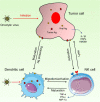Dendritic cells and natural killer cells: The road to a successful oncolytic virotherapy
- PMID: 36703982
- PMCID: PMC9871831
- DOI: 10.3389/fimmu.2022.950079
Dendritic cells and natural killer cells: The road to a successful oncolytic virotherapy
Abstract
Every type of cancer tissue is theoretically more vulnerable to viral infection. This natural proclivity has been harnessed as a new anti-cancer therapy by employing oncolytic viruses (OVs) to selectively infect and destroy cancer cells while providing little or no harm with no toxicity to the host. Whereas the primary oncolytic capabilities of OVs initially sparked the greatest concern, the predominant focus of research is on the association between OVs and the host immune system. Numerous OVs are potent causal agents of class I MHC pathway-related chemicals, enabling early tumor/viral immune recognition and cytokine-mediated response. The modified OVs have been studied for their ability to bind to dendritic cells (DCs) by expressing growth factors, chemokines, cytokines, and defensins inside the viral genome. OVs, like reovirus, can directly infect DCs, causing them to release chemokines and cytokines that attract and excite natural killer (NK) cells. In addition, OVs can directly alter cancer cells' sensitivity to NK by altering the expression levels of NK cell activators and inhibitors on cancerous cells. Therefore, NK cells and DCs in modulating the therapeutic response should be considered when developing and improving future OV-based therapeutics, whether modified to express transgenes or used in combination with other drugs/immunotherapies. Concerning the close relationship between NK cells and DCs in the potential of OVs to kill tumor cells, we explore how DCs and NK cells in tumor microenvironment affect oncolytic virotherapy and summarize additional information about the interaction mentioned above in detail in this work.
Keywords: cancer; dendritic cells; natural killer cells; oncolytic virotherapy; virus; virus immunology.
Copyright © 2023 Ghasemi, Abbasi, Ghanbari Naeini, Kokabian, Nameh Goshay Fard and Givtaj.
Conflict of interest statement
The authors declare that the research was conducted in the absence of any commercial or financial relationships that could be construed as a potential conflict of interest.
Figures


Similar articles
-
The two-faces of NK cells in oncolytic virotherapy.Cytokine Growth Factor Rev. 2020 Dec;56:59-68. doi: 10.1016/j.cytogfr.2020.06.005. Epub 2020 Jun 13. Cytokine Growth Factor Rev. 2020. PMID: 32586674 Review.
-
The emerging field of oncolytic virus-based cancer immunotherapy.Trends Cancer. 2023 Feb;9(2):122-139. doi: 10.1016/j.trecan.2022.10.003. Epub 2022 Nov 17. Trends Cancer. 2023. PMID: 36402738 Free PMC article. Review.
-
Targeting TBK1 potentiates oncolytic virotherapy via amplifying ICAM1-mediated NK cell immunity in chemo-resistant colorectal cancer.J Immunother Cancer. 2025 Jun 8;13(6):e011455. doi: 10.1136/jitc-2024-011455. J Immunother Cancer. 2025. PMID: 40484646 Free PMC article.
-
Natural Killer Cells Recruitment in Oncolytic Virotherapy: A Mathematical Model.Bull Math Biol. 2021 May 18;83(7):75. doi: 10.1007/s11538-021-00903-6. Bull Math Biol. 2021. PMID: 34008149
-
New hopes for the breast cancer treatment: perspectives on the oncolytic virus therapy.Front Immunol. 2024 Mar 21;15:1375433. doi: 10.3389/fimmu.2024.1375433. eCollection 2024. Front Immunol. 2024. PMID: 38576614 Free PMC article. Review.
Cited by
-
NK/DC crosstalk-modulating antitumor activity via Sema3E/PlexinD1 axis for enhanced cancer immunotherapy.Immunol Res. 2024 Dec;72(6):1217-1228. doi: 10.1007/s12026-024-09536-y. Epub 2024 Sep 5. Immunol Res. 2024. PMID: 39235526 Review.
-
Tumor associated macrophages as key contributors and targets in current and future therapies for melanoma.Expert Rev Clin Immunol. 2024 Aug;20(8):895-911. doi: 10.1080/1744666X.2024.2326626. Epub 2024 Mar 27. Expert Rev Clin Immunol. 2024. PMID: 38533720 Free PMC article. Review.
-
Overcoming resistant cancerous tumors through combined photodynamic and immunotherapy (photoimmunotherapy).Front Immunol. 2025 Jul 17;16:1633953. doi: 10.3389/fimmu.2025.1633953. eCollection 2025. Front Immunol. 2025. PMID: 40746528 Free PMC article. Review.
-
Intranasal Delivery of Oncolytic Adenovirus XVir-N-31 via Optimized Shuttle Cells Significantly Extends Survival of Glioblastoma-Bearing Mice.Cancers (Basel). 2023 Oct 10;15(20):4912. doi: 10.3390/cancers15204912. Cancers (Basel). 2023. PMID: 37894279 Free PMC article.
-
Virus Against Cancer: Paradigm-Shifting Biological Concepts.Curr Neurol Neurosci Rep. 2025 Jun 14;25(1):41. doi: 10.1007/s11910-025-01428-4. Curr Neurol Neurosci Rep. 2025. PMID: 40515944 Review.
References
Publication types
MeSH terms
Substances
LinkOut - more resources
Full Text Sources
Medical
Research Materials

